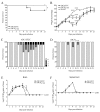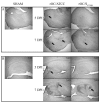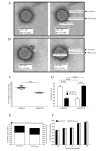Cleavage of a Neuroinvasive Human Respiratory Virus Spike Glycoprotein by Proprotein Convertases Modulates Neurovirulence and Virus Spread within the Central Nervous System
- PMID: 26545254
- PMCID: PMC4636366
- DOI: 10.1371/journal.ppat.1005261
Cleavage of a Neuroinvasive Human Respiratory Virus Spike Glycoprotein by Proprotein Convertases Modulates Neurovirulence and Virus Spread within the Central Nervous System
Abstract
Human coronaviruses (HCoV) are respiratory pathogens that may be associated with the development of neurological diseases, in view of their neuroinvasive and neurotropic properties. The viral spike (S) glycoprotein is a major virulence factor for several coronavirus species, including the OC43 strain of HCoV (HCoV-OC43). In an attempt to study the role of this protein in virus spread within the central nervous system (CNS) and neurovirulence, as well as to identify amino acid residues important for such functions, we compared the sequence of the S gene found in the laboratory reference strain HCoV-OC43 ATCC VR-759 to S sequences of viruses detected in clinical isolates from the human respiratory tract. We identified one predominant mutation at amino acid 758 (from RRSR↓ G758 to RRSR↓R758), which introduces a putative furin-like cleavage (↓) site. Using a molecular cDNA infectious clone to generate a corresponding recombinant virus, we show for the first time that such point mutation in the HCoV-OC43 S glycoprotein creates a functional cleavage site between the S1 and S2 portions of the S protein. While the corresponding recombinant virus retained its neuroinvasive properties, this mutation led to decreased neurovirulence while potentially modifying the mode of virus spread, likely leading to a limited dissemination within the CNS. Taken together, these results are consistent with the adaptation of HCoV-OC43 to the CNS environment, resulting from the selection of quasi-species harboring mutations that lead to amino acid changes in viral genes, like the S gene in HCoV-OC43, which may contribute to a more efficient establishment of a less pathogenic but persistent CNS infection. This adaptative mechanism could potentially be associated with human encephalitis or other neurological degenerative pathologies.
Conflict of interest statement
The authors have declared that no competing interests exist.
Figures









References
-
- Talbot PJ, Jacomy H, Desforges M. Pathogenesis of human coronaviruses other than severe acute respiratory syndrome coronavirus In: Perlman S, Gallagher T, Snijder EJ, editors. The Nidoviruses. ASM Press; 2008. pp. 313–24.
-
- Desforges M, Le Coupanec A, Brison E, Meessen-Pinard M, Talbot PJ. Neuroinvasive and neurotropic human respiratory coronaviruses: potential neurovirulent agents in humans. Advances in experimental medicine and biology. 2014;807:75–96. Epub 2014/03/13. 10.1007/978-81-322-1777-0_6 . - DOI - PMC - PubMed
Publication types
MeSH terms
Substances
Grants and funding
LinkOut - more resources
Full Text Sources
Other Literature Sources
Molecular Biology Databases

